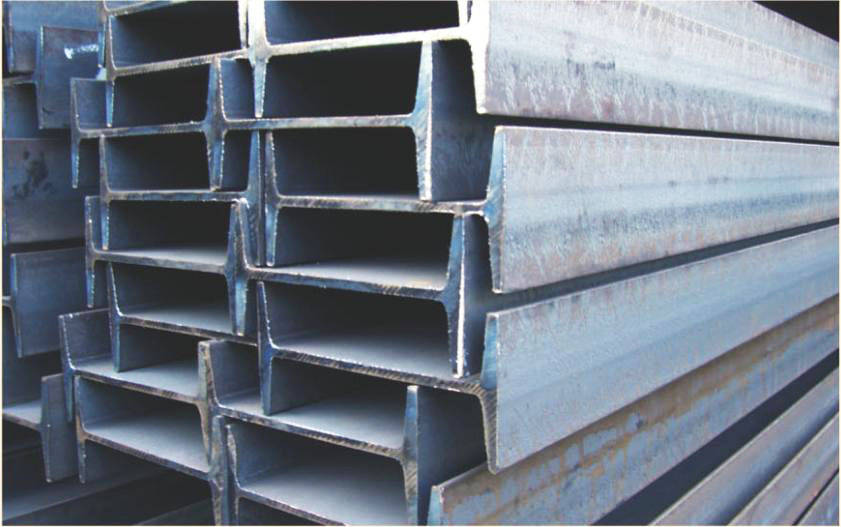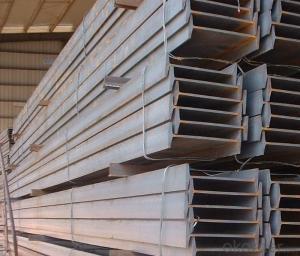Mild Steel I-Beam Steel Profiles
- Loading Port:
- China main port
- Payment Terms:
- TT or LC
- Min Order Qty:
- 2000 PCS
- Supply Capability:
- 30000 PCS/month
OKorder Service Pledge
OKorder Financial Service
You Might Also Like
OKorder is offering high quality Mild Steel I-Beams at great prices with worldwide shipping. Our supplier is a world-class manufacturer of steel, with our products utilized the world over. OKorder annually supplies products to European, North American and Asian markets. We provide quotations within 24 hours of receiving an inquiry and guarantee competitive prices.
Product Applications:
Mild Steel I-Beams are ideal for structural applications and are widely used in the construction of buildings and bridges, and the manufacturing, petrochemical, and transportation industries.
Product Advantages:
OKorder's Mild Steel I-Beams are durable, strong, and resist corrosion.
Main Product Features:
· Premium quality
· Prompt delivery & seaworthy packing (30 days after receiving deposit)
· Corrosion resistance
· Can be recycled and reused
· Mill test certification
· Professional Service
· Competitive pricing
Product Specifications:
Brand: Jinding
Grade: SS400 – SS490
Standard: JIS, ASTM, GB
Packaging: Export packing, nude packing, bundled
Place of Origin: Hebei, China
FAQ:
Q1: Why buy Materials & Equipment from OKorder.com?
A1: All products offered byOKorder.com are carefully selected from China's most reliable manufacturing enterprises. Through its ISO certifications, OKorder.com adheres to the highest standards and a commitment to supply chain safety and customer satisfaction.
Q2: How do we guarantee the quality of our products?
A2: We have established an advanced quality management system which conducts strict quality tests at every step, from raw materials to the final product. At the same time, we provide extensive follow-up service assurances as required.
Q3: How soon can we receive the product after purchase?
A3: Within three days of placing an order, we will begin production. The specific shipping date is dependent upon international and government factors, but is typically 7 to 10 workdays.
Q4: What makes stainless steel stainless?
A4: Stainless steel must contain at least 10.5 % chromium. It is this element that reacts with the oxygen in the air to form a complex chrome-oxide surface layer that is invisible but strong enough to prevent further oxygen from "staining" (rusting) the surface. Higher levels of chromium and the addition of other alloying elements such as nickel and molybdenum enhance this surface layer and improve the corrosion resistance of the stainless material.
Q5: Can stainless steel rust?
A5: Stainless does not "rust" as you think of regular steel rusting with a red oxide on the surface that flakes off. If you see red rust it is probably due to some iron particles that have contaminated the surface of the stainless steel and it is these iron particles that are rusting. Look at the source of the rusting and see if you can remove it from the surface.
Images:


- Q: How do steel I-beams perform in extreme weather conditions?
- Steel I-beams perform well in extreme weather conditions due to their strength and durability. They can withstand high winds, heavy snow loads, and extreme temperatures without warping or bending. Additionally, their resistance to corrosion makes them suitable for withstanding harsh environmental conditions.
- Q: Can steel I-beams be used in multi-story buildings?
- Yes, steel I-beams are commonly used in multi-story buildings due to their high strength-to-weight ratio, rigidity, and versatility in supporting heavy loads. They provide structural support and stability, making them a preferred choice for constructing tall buildings that require a robust framework.
- Q: Can steel I-beams be used for industrial shelving?
- Yes, steel I-beams can be used for industrial shelving. Steel I-beams are commonly used in construction and can provide excellent strength and durability for industrial shelving applications. They offer high load-bearing capacity, making them suitable for storing heavy items or equipment. Additionally, the versatility of steel allows for the customization of shelving units to meet specific industry requirements.
- Q: How do you calculate the weight of a steel I-beam?
- To calculate the weight of a steel I-beam, you need to know its dimensions (length, height, and width) and the density of steel. Multiply the volume of the I-beam (length x height x width) by the density of steel to determine its weight.
- Q: Can steel I-beams be used in coastal areas prone to saltwater exposure?
- Certainly, steel I-beams can be utilized in coastal regions that are susceptible to saltwater exposure. Nevertheless, it is crucial to take into account the potential impact of saltwater on the steel beams and adopt necessary precautions to prevent corrosion. Saltwater, containing high levels of salt, can expedite the corrosion process of steel. In order to mitigate this hazard, a number of strategies can be employed. In the first place, it is indispensable to employ corrosion-resistant coatings on the steel beams. These coatings, such as zinc or epoxy coatings, act as a barrier between the steel and the saltwater, averting direct contact and reducing the likelihood of corrosion. It is necessary to conduct regular inspections and maintenance of these coatings to ensure their long-term effectiveness. Secondly, it is necessary to implement proper ventilation and drainage systems to minimize the accumulation of saltwater on the steel beams. This measure helps in preventing prolonged exposure to saltwater, thereby diminishing the risk of corrosion. Thirdly, it is important to choose the appropriate type of steel for the I-beams. Stainless steel or galvanized steel, which possess higher resistance to corrosion, are commonly recommended for structures in coastal areas. Lastly, regular maintenance and monitoring of the steel beams are vital to identify and address any indications of corrosion at an early stage. This may entail routine inspections, cleaning, and application of additional protective coatings as required. By implementing these measures, steel I-beams can be effectively utilized in coastal areas vulnerable to saltwater exposure, ensuring structural integrity and durability over time.
- Q: It's not clear what difference between I-beam and channel steel What's the difference between the formulas for the two materials?
- Different from H steel and I-beam, H steel is better than I-beamGB_706-1988_ dimensions, shape, weight and allowable deviation of hot rolled I-beamGB_T_11263-2005_ hot rolled H and split T section steel
- Q: Can steel I-beams be used in healthcare facilities or hospitals?
- Indeed, healthcare facilities and hospitals can utilize steel I-beams. Construction frequently relies on steel I-beams because of their robustness, longevity, and capacity to bear substantial loads. In healthcare facilities, where both safety and structural stability are paramount, these beams are frequently employed to establish a sturdy foundation for the building. These beams are capable of supporting the weight of walls, floors, and ceilings, thereby guaranteeing the overall stability of the structure. Furthermore, steel I-beams possess fire and pest resistance, rendering them particularly suitable for healthcare facilities, where safety and hygiene are of utmost significance.
- Q: Can steel I-beams be used in renovation projects?
- Yes, steel I-beams can be used in renovation projects. They are often used to reinforce existing structures, provide additional support, or to create open floor plans by removing load-bearing walls. Steel I-beams are known for their strength and durability, making them a popular choice for renovation projects that require structural modifications.
- Q: How do steel I-beams perform in terms of impact insulation?
- Steel I-beams are not very effective in terms of impact insulation. Due to their rigid and dense structure, they do not absorb or dampen impact energy effectively. Therefore, steel I-beams are not suitable for applications where impact insulation is a priority.
- Q: Can steel I-beams be used for industrial machinery?
- Yes, steel I-beams can be used for industrial machinery. Steel I-beams are commonly used in construction and engineering projects due to their strength, durability, and load-bearing capabilities. They can be effectively utilized in the construction of heavy-duty industrial machinery frames and supports, providing stability and structural integrity.
Send your message to us
Mild Steel I-Beam Steel Profiles
- Loading Port:
- China main port
- Payment Terms:
- TT or LC
- Min Order Qty:
- 2000 PCS
- Supply Capability:
- 30000 PCS/month
OKorder Service Pledge
OKorder Financial Service
Similar products
Hot products
Hot Searches
Related keywords























